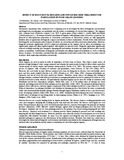| dc.description.abstract | Greenhouse experiments were conducted over 2 cropping cycles to investigate the effect of fungicide seed treatment
and fungal root rot pathogens on nodulation and dry matter accumulation of selected food legumes. The legumes
were common bean (Phaseolus vulgaris L.var GLP 2), green gram (Vigna radiata L., variety M66) and lablab
(Lablab purpureus L.). Treatments included, inoculation of legumes with pathogen alone (Fusarium oxysporum f.sp.
phaseoli or Macrophomina phaseolina or Sclerotinia sclerotiorum or Rhizoctonia solani), or with appropriate
rhizobia alone or application of fungicide (copper oxychloride) or their combinations. Results of the study indicated
that fungicide seed treatment reduced disease incidence on Sclerotinia and Rhizoctonia inoculated plants. However,
fungicide treatment significantly (p=0.05) depressed nodulation of the legumes but its effect on nodulation was
significantly suppressed when applied together with rhizobia on infected seeds. Fungicide application significantly
reduced seedlings mortality (pre-emergence damping off) and number of nodules per plant but had no effect on dry
matter accumulation. Combination of fungicide and rhizobia inoculation improved nodulation as well as reducing
disease incidence. It is therefore concluded that this combination yields better results if the aim is to reduce root rot
incidence while improving nodulation concurrently. | en |

